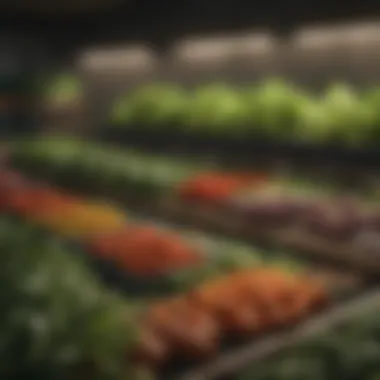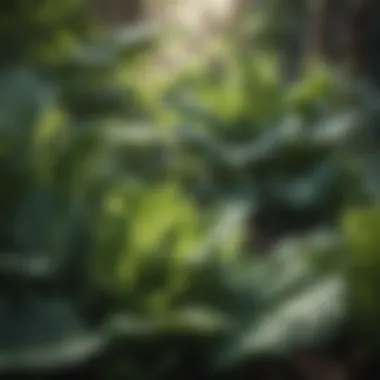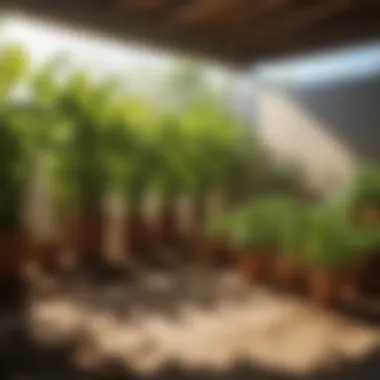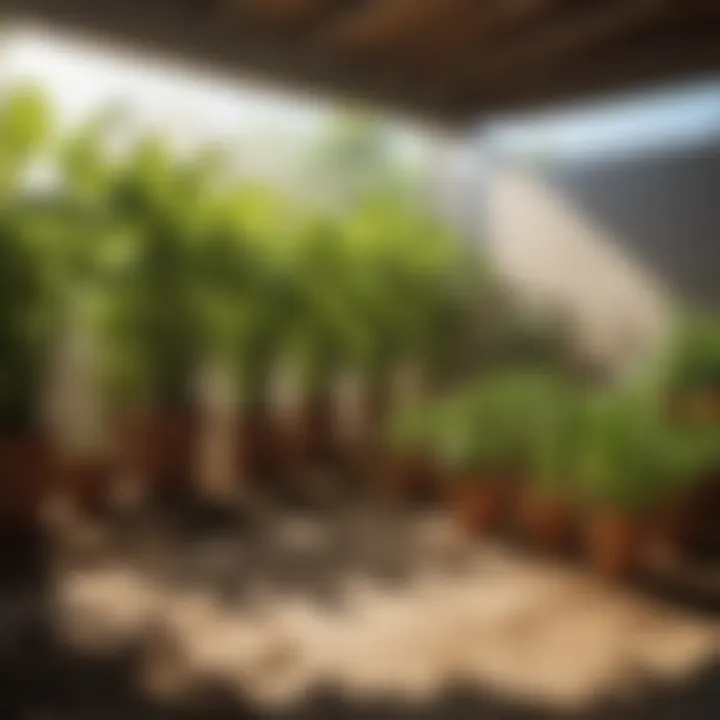Shade for Vegetable Gardens: Light's Role in Growth


Intro
In vegetable gardening, light exposure presents a pivotal factor influencing the health and yield of crops. Understanding the harmonic relationship between sunlight and shade can greatly enhance a gardener's success. This article delves into the various aspects of shade within vegetable gardens, including its types, effects on different vegetables, and strategies for managing both light and shade effectively. By grasping these concepts, gardeners can optimize their growing conditions and maximize productivity.
Understanding Shade in Vegetable Gardens
Shade is often viewed as a detrimental element in gardening. However, it can actually provide essential relief from excessive sunlight, particularly during the peak summer heat. Certain crops thrive with a measured amount of shade, while others may suffer from insufficient light. The critical insight lies in recognizing that the needs of your crops will differ significantly based on their species and growth stage.
Types of Shade Structures
There are various methods to introduce shade into vegetable gardens, each with its distinct characteristics:
- Temporary Shade Cloths: These are lightweight and flexible options that come in various densities. Gardeners can easily move and adjust them according to the requirements of the plants.
- Permanent Structures: Pergolas or trellises, often constructed with slatted wood or fabric, offer long-term solutions. These structures can shade specific areas from harsh sunlight and can also support climbing crops.
- Natural Shade: Existing trees or shrubs can create natural shade environments. However, it's essential to assess whether they compete for nutrients and water, which can negatively impact vegetable plants.
Effects of Shade on Various Vegetables
Not all vegetables respond similarly to shade. Certain plants display a robust adaptability, while others may languish under reduced light. Here are some examples:
- Leafy Greens: Vegetables like spinach and lettuce typically flourish with some shade, especially during the warmer months.
- Root Vegetables: Carrots and radishes can grow well in semi-shaded areas as they benefit from the cooler temperatures.
- Fruit-Bearing Plants: Tomatoes and peppers, in contrast, generally require full sun. Excessive shading can lead to decreased fruit yields, making their siting critical in garden planning.
"Proper shade management can elevate vegetable quality and yield, tailoring to individual plant needs while mitigating heat stress."
Practical Strategies for Managing Shade
Managing shade effectively involves a blend of observation and strategic planning. Here are some practical strategies to consider:
- Assess Light Patterns: Observe how sunlight hits your garden through different times of the day. Understanding these patterns aids in placing shade structures appropriately.
- Space Planting: Ensure a layout that prevents taller crops from casting excessive shade on shorter ones.
- Rotate Crops: Change the planting position of crops yearly, taking into account their light requirements. This rotational strategy promotes balance in light exposure.
By acknowledging the multifaceted impact of shade on vegetable gardening, one can create an environment conducive to healthy growth and abundant harvests. This narrative balances the intricate relationship of light management, enabling both novice and experienced gardeners to make insightful decisions tailored to their specific needs.
Preface to Shade in Vegetable Gardens
Shade plays a significant role in the realm of vegetable gardening. Understanding its implications is essential for optimizing growth and yield. While sunlight is often heralded as the primary factor in plant health, shade should not be overlooked. It offers a protective cover that can moderate temperature, conserve moisture, and provide relief from excessive sun exposure.
The intricate relationship between sunlight and shade influences how different vegetables thrive in a garden setting. This exploration into shade enables gardeners to harness its potential benefits while mitigating risks associated with too much or too little light.
There are several key elements to consider regarding shade:
- Light Requirements: Different vegetables have varying light preferences. Knowing these requirements helps in planning an effective layout.
- Temperature Management: Shade can reduce heat stress during peak sunlight hours, promoting healthier plants.
- Moisture Retention: Soil under shade can stay moist longer, reducing the need for constant watering.
In essence, incorporating shade into vegetable gardens is not merely about blocking the sunlight but rather about finding that delicate balance that fosters optimal growth conditions.
The Importance of Sunlight for Vegetables
Sunlight is the cornerstone of photosynthesis, the process through which plants convert light energy into chemical energy. For vegetables, adequate sunlight is vital as it directly correlates to their growth rate, flavor development, and overall vigor. Each vegetable variety has a unique light requirement, influencing its potential yield.
Generally, most vegetables fall into three categories based on their light needs:
- Full Sun: These plants require a minimum of six hours of direct sunlight each day, fostering robust growth and higher yields. Examples include tomatoes and peppers.
- Partial Shade: These plants thrive with around four to six hours of sunlight. Leafy greens, such as spinach and lettuce, appreciate this balance.
- Full Shade: Some vegetables can tolerate only minimal sunlight, usually less than four hours, like certain varieties of mushrooms.
Farmers and gardeners must be mindful of these needs while selecting locations for planting.
Understanding Shade: A Dual Nature
Shade presents a dual nature that can either benefit or hinder plant growth, depending on several factors. Too much shade can lead to weaker plants due to insufficient light for photosynthesis, resulting in stunted growth and poor yields. Conversely, the right amount of shade can enhance growth by protecting plants from excessive sunlight and heat stress.
There are various sources of shade, including:
- Natural Shade: Provided by trees and taller plants, this type of shade creates a dappled effect, allowing some light to filter through.
- Artificial Shade: Structures such as canopies, shade cloths, or even garden furniture can create specific shaded areas tailored for particular vegetable needs.
The impact of shade on vegetable crops depends on its degree and duration. Gardeners need to assess the specific light needs of their chosen crops, paying attention to how and when light levels fluctuate across seasons. Understanding this dual nature helps in making informed choices for garden design and vegetable selection.
Types of Shade in Gardening
Understanding the different types of shade is crucial for effective vegetable gardening. Shade impacts not only the growth rates of plants but also their overall health and yield. Each type of shade comes with its own set of characteristics and potential benefits. Knowing these will aid gardeners in making informed decisions and managing their gardens more effectively.
Natural Shade: Trees and Shrubs
Natural shade is often the result of taller green structures, primarily trees and shrubs surrounding a garden. This type of shade can have both positive and negative effects.
Benefits:
- Natural shade can provide relief from intense sunlight, particularly in hot climates.
- It can help maintain moisture levels in the soil, reducing watering needs.
- The cooler microclimate created by trees may promote better growth for shade-tolerant vegetables.
Considerations:


- Not all trees or shrubs are suitable; some may compete with vegetable plants for nutrients and water.
- The shape and density of the canopy must be considered to ensure adequate light still reaches the plants.
Artificial Shade: Structures and Fabrics
Artificial shade includes all man-made methods of shading plants, such as shade cloth, awnings, or other cover structures.
Advantages:
- Adjustable, allowing precise management of light levels based on the specific needs of different crops.
- Can be used strategically to protect young plants from harsh sun while allowing mature plants to receive more light.
Usage:
- Shade cloth comes in various densities and colors, each providing a different level of shading.
- Building structures like pergolas or canopies can add aesthetic appeal while serving a practical purpose.
Dappled Shade vs. Full Shade
Understanding the distinction between dappled shade and full shade is essential for planning.
Dappled Shade:
- Occurs when sunlight filters through leaves, producing light and shaded areas in a garden.
- Most vegetables can benefit from this type of shade, as it allows for some sunlight exposure while still reducing heat stress.
Full Shade:
- Is when an area receives very little direct sunlight, often found under dense canopies.
- Many vegetable crops cannot thrive in full shade, which can lead to poor growth and lower yields.
"Gardening is a reflection of life—both thrive in balance. Understanding shade is essential for successful vegetable growing."
In summary, the choice of shade type can significantly influence crop growth. Knowing how to utilize natural shade from trees and shrubs versus artificial shade structures will help you create an environment that suits your vegetable garden's needs.
Impact of Shade on Vegetable Growth
When discussing vegetable gardening, the role of shade is crucial yet often misunderstood. Shade can affect various aspects of growth in vegetables, ultimately influencing both their vitality and yield. Understanding the impact of shade on vegetable growth enables gardeners to better plan their planting strategies and select appropriate locations for specific crops. This section delves into how shade interacts with essential plant functions, tolerance levels of various vegetables to shade, and the concept of microclimates that can arise from shaded environments.
Photosynthesis and Light Requirements
Photosynthesis is the cornerstone of plant development. Vegetables require sunlight to synthesize nutrients, and the amount of light directly influences their growth and productivity. Generally, plants have specific light requirements, defined as full sun, partial shade, or full shade.
- Full sun typically means around six hours of direct sunlight a day.
- Partial shade indicates a range of three to six hours.
- Full shade usually sees less than three hours of sunlight.
The arrangement of light can change throughout the day, making it critical to monitor the light conditions of the garden. Insufficient light can stunt growth, leading to weak plants that are more susceptible to pests and diseases. Therefore, knowing a plant's specific light needs plays an important role in its success.
Shade Tolerance in Vegetables
Different vegetables exhibit varying degrees of shade tolerance. Some plants, such as leafy greens like lettuce and spinach, can thrive in lower light conditions. These greens utilize available light efficiently, allowing them to grow even when not exposed to full sun.
On the opposite side are fruiting vegetables like tomatoes and peppers, which typically require more sunlight to produce fruits effectively. Understanding these differences helps in orchestrating a vegetable garden that maximizes production while accommodating each plant's light needs.
- Highly tolerant to shade: Lettuce, Spinach, Kale
- Moderately tolerant: Radishes, Beets, Cabbage
- Low tolerance: Tomatoes, Peppers, Cucumbers
Gardeners need to evaluate the types of vegetables they grow alongside how much shade is cast in their garden areas. This will aid in making informed decisions for successful plant cultivation.
Heat Stress and Microclimates
Shade not only affects light but also temperature regulation. Vegetables exposed to excessive heat may suffer from stress, leading to wilting, stunted growth, or even death. Shaded areas often create microclimates, which can moderate temperatures and provide relief from midday heat.
- In full sun, soil can dry out quickly, stressing plants, whereas shaded areas retain moisture.
- These cooler zones can protect crops from extreme heat events.
Gardeners should observe the behavior of their plants within shaded areas. This awareness helps in adapting watering practices and choosing the right vegetables that can flourish in these conditions. Recognizing the balance between sunlight, shade, and temperature is key to sustaining a healthy vegetable garden.
"Understanding the interplay between shade and light is fundamental to maximizing yield in vegetable gardening."
In summary, the impact of shade on vegetable growth encompasses many factors. From understanding light requirements to examining shade tolerance and the benefits of microclimates, gardeners can harness these insights to create optimal growing conditions. This helps nurture vigorous plants, ultimately leading to higher yields.
Managing Shade in Vegetable Gardens
Managing shade in vegetable gardens is crucial for achieving a balance between adequate light exposure and protection from potential overexposure. Different vegetable species have distinct light requirements. Understanding these needs is vital for fostering plant development and maximizing yields. The objective is not just to shield crops from excessive sunlight but also to ensure they receive enough light for photosynthesis. This nuanced approach benefits both novice and seasoned gardeners aiming for successful crop growth in varied light conditions.
Planning for Optimal Sun Exposure
Planning is essential when it comes to the optimal sun exposure for your vegetable garden. Begin by assessing the garden's layout and the path of the sun throughout the day. Take note of any structures, trees, or other plants that may cast shadows. This information will guide you in placing sun-loving vegetables in areas that maintain direct exposure for the longest part of the day.
- Considerations for Planning:
- Sun Patterns: Observe how sunlight moves across your garden. Morning rays can be softer, while afternoon light is more intense.
- Seasonal Variations: Sunlight shifts with the changing seasons. In winter, shadows may lengthen, impacting plant growth.
- Vegetable Grouping: Group vegetables with similar light needs together. This allows for efficient garden utilization, making it easier to manage shade and light.
Selecting the Right Location


Selecting a suitable location for seeds or seedlings is another fundamental aspect of shade management. Locations should align with the light requirements specific to the types of vegetables being grown.
- Key Factors in Location Selection:
- Natural Barriers: Evaluate how trees, buildings, or fences may create unexpected shade. Tall plants can also obscure sunlight, so factor their height at maturity into your planning.
- Soil Quality: Ensure the chosen location supports healthy soil conditions. Good soil will help plants thrive even with less sunlight.
- Accessibility: Maintain easy access to your garden, allowing for regular maintenance and monitoring of shade conditions.
Adjusting Shade Throughout the Growing Season
Throughout the growing season, the light environment in your garden changes. It is necessary to remain adaptable and make adjustments to ensure plants receive adequate sunlight as they grow.
- Adjusting Strategies:
- Repositioning Shade Structures: If you use temporary shade structures, be willing to move them as daylight grows or shrinks. Seasoned gardeners might consider collapsible screening that can adjust easily.
- Monitoring Plant Growth: Keep an eye on how vegetables respond to their light conditions. If some plants seem leggy or sparse, they may need additional sunlight.
- Utilizing Companion Planting: Reach out for opportunities to integrate companion plants that can provide shade to more sensitive crops while still allowing sun to reach others.
Effective shade management not only enhances vegetable growth but also promotes healthier garden ecosystems.
Being attentive to these aspects can greatly improve the productivity of your vegetable garden while ensuring that specific plants thrive in their most favorable light conditions.
Vegetable Varieties and Their Shade Needs
Understanding the specific light requirements of various vegetable varieties is crucial for successful gardening. Different vegetables react to shade in unique ways. Awareness of these differences can help gardeners make informed decisions when planning and managing their garden spaces. Each variety has its own optimal conditions, which directly affects its growth, yield, and resilience against pests and diseases.
Gardeners should consider not only sunlight exposure but also the time of day that shade occurs and for how long. This article section will focus on three main categories of vegetables: leafy greens, root vegetables, and fruiting vegetables.
Leafy Greens: Thrive in Partial Shade
Leafy greens such as spinach, lettuce, and kale often prefer cooler conditions. Those vegetables can benefit from partial shade, particularly during warmer months. Shaded environments can help prevent bolting, which is when leafy greens flower prematurely.
Some essential points regarding leafy greens and their need for shade include:
- Improved Flavor: Shade can enhance the flavor of leafy greens, making them sweeter.
- Extended Growing Season: The partial shade provides an ideal environment for longer cultivation periods.
- Disease Resistance: Less sunlight can reduce the risk of leaf scorch and certain fungal diseases.
Gardening aficionados should consider implementing shade structures made of cloth or consider planting these greens near taller plants that can provide the necessary cover.
Root Vegetables: Effects of Shade
Root vegetables, including carrots, radishes, and beets, also exhibit a range of responses to shade. Unlike leafy greens, many root vegetables can be somewhat sensitive to excessive shade.
Here are significant factors to consider relating to root vegetables and shade:
- Growth Rate: Reduced light can slow down the growth rate. Insufficient sunlight leads to smaller root sizes.
- Quality of Vegetables: Persistence in shade might impact texture and nutrient composition, noticeably changing the quality of harvest.
- Companionship: Strategic planting with leafy greens, which thrive in partial shade, can create a beneficial microclimate for all plants involved.
It is important to assess shade levels when planting root vegetables. Too much shade will hinder their development.
Fruiting Vegetables: Sun Lovers
Fruiting vegetables like tomatoes, peppers, and cucumbers require a substantial amount of sunlight. These crops generally thrive in full sun and do not tolerate shade well.
Key considerations for growing these sun-loving vegetables include:
- Higher-Yield Potential: Maximum exposure to sunlight leads to better flowering and fruit set.
- Flavor Development: Extra sunlight accentuates the flavor, especially in tomatoes and peppers.
- Increased Pest Resistance: Well-lit plants can better withstand pest attacks compared to those grown in shade.
Homeowners should position these plants in areas that receive direct sunlight for most of the day, ensuring optimal growth and a fruitful harvest.
In summary, understanding the shade preferences of different vegetable varieties helps create a balanced garden. The right amount of light contributes significantly to plant health and productivity.
Creating Shade in Vegetable Gardens
Creating shade in vegetable gardens plays a crucial role in optimizing plant growth and maximizing yields. It is not solely about blocking sunlight; it encompasses the careful balance between light, water, and temperature. Too much direct sunlight can lead to heat stress, while inadequate light can affect photosynthesis. Thus, understanding the process and methods of creating shade is essential for gardeners aiming to cultivate a productive vegetable garden.
Shade can protect plants from extreme weather conditions and enable gardeners to grow a wider variety of crops. It contributes to the establishment of microclimates, which are particularly valuable for temperate and subtropical regions. By implementing shade strategies, homeowners can enhance water retention and reduce soil evaporation. This ultimately leads to less water usage and promotes a sustainable gardening practice.
Using Shade Cloth: Types and Applications
Shade cloth is an effective way to manage light exposure for vegetables. It is available in various types, including knitted and woven varieties, which offer different levels of shade ranging from 30% to 90%. Choosing the right shade cloth depends on the specific needs of the crops being grown.
One popular application is using shade cloth over rows of seedlings to prevent sunburn and wilting. Placing it at an angle can create dappled light, which some plants appreciate. Another application is utilizing shade cloth to cover outdoor workspaces, keeping the area cool while gardeners tend to their plants.
Key considerations when using shade cloth:
- Density: Select appropriate density based on plant needs.
- Placement: Make sure it is supported properly to withstand wind.
- Timing: Adjust the cloth during different growth stages.
Building Temporary Shade Structures
Temporary shade structures offer flexibility in managing light for different plants and evolving weather conditions. Gardeners can create these structures using simple materials such as stakes, PVC pipes, or even repurposed furniture.
Constructing a frame and draping it with fabric or shade cloth is a common approach. It allows for adjustments as needed, accommodating plants growing at varying heights.


Important aspects to consider include:
- Height of the structure: Must allow for air circulation.
- Material choice: Should be durable yet lightweight for easy removal.
- Mobility: Structures should be easy to reposition throughout the season.
Integrating Plants for Natural Shade
Using plants to create natural shade is both practical and beneficial for the ecosystem. Taller plants like sunflowers or certain trees can provide dappled light for more sensitive crops. This method enhances biodiversity and can attract beneficial insects.
When planning a garden, consider companion planting. For instance, growing leafy greens beneath a trellis of beans can result in a mutually beneficial relationship. Beans provide some shade while also enriching the soil.
Benefits of integrating plants for shade:
- Habitat creation: Support local fauna and flora.
- Soil health: Minimize soil erosion.
- Aesthetic value: Adds visual interest to the garden.
As gardeners explore ways to create shade, remember that a thoughtful balance between light and shadow can yield significant results in vegetable growth and health.
Monitoring and Adjusting Light Conditions
Effective monitoring and adjusting light conditions plays an essential role in the success of vegetable gardening. As light directly influences plant health and growth, understanding how it varies throughout seasons can be a major determinant of crop yield. With the right approach to light management, gardeners can optimize their vegetable production and ensure plants receive the necessary sunlight or shade. Adapting to changing conditions enhances resilience to weather fluctuations and promotes consistent vegetable growth.
Tools for Measuring Light Levels
To accurately monitor light levels in your vegetable garden, several tools can help assess the amount of sunlight each area receives. These tools include lux meters, light sensors, and photometers.
- Lux Meters: A lux meter measures illumination in a given area, providing insight into how much light reaches the plants. Knowing the lux values helps gardeners decide the suitability of various crops for particular locations.
- Light Sensors: These devices measure light intensity over time and can help monitor how light levels change throughout the day and season. This is especially useful for longer-term garden planning.
- Photometers: Similar to lux meters, photometers offer a more sophisticated means of measuring light quality and quantity. They provide detailed data about various wavelengths, which can be important for understanding specific plant light requirements.
Each of these tools can help clarify how much light is available for growth and guide the decision-making process on where to plant each vegetable variety.
Keeping Track of Seasonal Changes
Seasonal changes create shifts in sunlight availability that every gardener needs to track. Sun angles change throughout the year, resulting in varying light patterns in your garden. Here are a few strategies to keep in mind for effective tracking:
- Record Sun Path: Use a notebook or gardening app to note the sunlight hours for different garden areas as seasons progress. Understanding how sunlight moves across your garden helps anticipate where adjustments might be necessary.
- Monitor Plant Growth: Keep an eye on how your plants respond to different light conditions. Leaf growth direction can indicate if a vegetable is reaching for more light.
- Utilize Seasonal Charts: Many gardening resources provide seasonal charts that outline the expected sunlight hours throughout the year. Reference these to understand general patterns and anticipate changes in your garden.
"Making systematic observations about light conditions during different seasons allows gardeners to make informed decisions for future planting."
By being diligent in light measurement and observation, gardeners can adapt their practices, ensuring vegetables receive optimal conditions for growth. This can lead to healthier plants and an impressive vegetable harvest.
Common Mistakes in Shade Management
Understanding how to manage shade effectively is crucial for any successful vegetable garden. Mistaken approaches to shade can lead to unproductive plants and poor yields. This section addresses common errors made in shade management and emphasizes the importance of avoiding these pitfalls.
Overly Dense Shade: Consequences
Creating a garden with excessively dense shade can lead to negative outcomes for vegetable growth. While some plants benefit from partial shade, an overly shaded environment can inhibit photosynthesis, the process by which plants convert sunlight into energy. Without adequate light, vegetables such as tomatoes and peppers may experience stunted growth or fail to produce fruit altogether.
- Reduced Photosynthesis: Plants may look healthy at first, but lacking sufficient light will lower their overall vigor.
- Pest Infestations: Dense shade can create a microclimate conducive to pests like aphids and whiteflies, which thrive in humid conditions.
- Disease Development: Shade can increase humidity, promoting fungal diseases like blight and mildew.
To avoid these issues, gardeners must assess the level of shade carefully and make adjustments. This may involve pruning trees or planting different crops that better tolerate shaded conditions.
Ignoring Seasonal Sun Patterns
Another common mistake is disregarding how seasonal changes affect sunlight availability. The sun's position shifts throughout the year, causing shadows to lengthen or shorten based on the season. Ignoring these changes can result in plants receiving inadequate light during key growth periods.
- Spring and Summer Growth: During these seasons, ensuring that your garden receives ample sun is essential for germination and bloom.
- Fall and Winter Adjustments: As foliage dies back or trees lose leaves, it is possible that a previously shaded area may gain more light. Therefore, this period may need a reassessment of plant placement.
Gardeners should monitor their gardens regularly and document how sun patterns change with the seasons. By doing so, they can better predict when shade might become more or less of a factor in their garden's health.
Always keep seasonal variability in mind. Changing sun patterns can drastically affect your garden's productivity.
By avoiding the mistake of dense shade as well as being mindful of seasonal sun patterns, gardeners will find greater success. Ensuring that their crops have the right light conditions will lead to healthier plants and more abundant harvests.
Ending: The Balance of Sunlight and Shade
Shade plays a vital role in the growth of vegetable crops. Understanding how to balance sunlight with shade can be the difference between a thriving garden and a struggling one. Proper light conditions can enhance photosynthesis, improve plant health, and increase yields. However, one must consider the unique light requirements of different vegetables. Each crop has specific needs for sunlight and shade, which contributes to overall growth and productivity.
To achieve optimal results, one must consider several elements. These include the percentage of sunlight needed, the type of shade that affects the garden, and how seasonal changes impact light exposure. Valuing these elements will support sustainable gardening practices overall.
"Finding the right balance between sunlight and shade is essential for maximizing your vegetable garden's productivity."
By recognizing the significance of shading and enhancing light conditions, gardeners can create microclimates that support growth. This awareness goes beyond just productivity. It involves understanding ecological relationships and making informed decisions that align with sustainable gardening principles.
Reflections on Sustainable Gardening Practices
Sustainable gardening practices revolve around minimizing negative environmental impacts. Achieving this requires a delicate understanding of the relationship between sunlight, shade and crop health. Using shade structures effectively can conserve water, reduce the need for chemical fertilizers, and promote biodiversity. Planning for seasonal changes in sunlight can also reduce the energy needed for garden maintenance.
Gardeners should assess their specific climates and terrain. This knowledge helps in determining the right balance of sunlight and shade for various plants. For instance, planting shade-tolerant vegetables can create a layered garden effect, enhancing growth while limiting resource competition. This kind of practice ensures longevity for both the garden and the ecosystem.
Final Thoughts on Vegetable Growth and Light Management
Effective light management is integral to the success of a vegetable garden. The interplay between sunlight and shade plays a crucial role in photosynthesis, nutrient uptake, and ultimately plant health. Understanding which vegetables thrive in different light conditions allows gardeners to make strategic choices. By selecting appropriate crops according to their light needs, gardeners can mitigate risks associated with inadequate sunlight or excessive shade.
Plan for the shifts in light exposure throughout the seasons. Using tools to monitor light levels can improve your gardening practices. Adjustments can be made based on these findings, enabling flexibility and responsiveness to changing conditions.















